Homogeneous Nanostructured VO2@SiO2 as an Anti-Reflecting Layer in the Visible/Near Infrared Wavelength
Abstract
:1. Introduction
2. Materials and Methods
2.1. Subsection Synthesis of Vanadium Oxide@Pattern SiO2 Nanostructure
2.2. Characterization
3. Results and Discussion
4. Conclusions
Author Contributions
Funding
Institutional Review Board Statement
Informed Consent Statement
Data Availability Statement
Conflicts of Interest
References
- Helveston, J.P.; He, G.; Davidson, M.R. Quantifying the cost savings of global solar photovoltaic supply chains. Nature 2023, 612, 83–87. [Google Scholar] [CrossRef]
- Hassan, S.; Dhimish, M. Review of current state-of-the-art research on photovoltaic Soiling, anti-reflective coating, and solar roads deployment supported by a pilot experiment on a PV Road. Energies 2022, 15, 9620. [Google Scholar] [CrossRef]
- Ito, S.; Murakami, T.N.; Comte, P.; Liska, P.; Grätzel, C.; Nazeeruddin, M.K.; Grätzel, M. Fabrication of thin film dye sensitized solar cells with solar to electric power conversion efficiency over 10%. Thin Solid Film. 2008, 516, 4613–4619. [Google Scholar] [CrossRef]
- Pendry, J.B.; Schurig, D.; Smith, D.R. Controlling electromagnetic fields. Science 2006, 312, 1780–1782. [Google Scholar] [CrossRef] [PubMed]
- Leonhardt, U.; Tyc, T. Broadband invisibility by non-Euclidean cloaking. Science 2009, 323, 110–112. [Google Scholar] [CrossRef] [PubMed]
- Priyadarshini, B.G.; Sharma, A.K. Design of multi-layer anti-reflection coating for terrestrial solar panel glass. Bull. Mat. Sci. 2016, 39, 683–689. [Google Scholar] [CrossRef]
- Zäll, E.; Järn, M.; Karlsson, S.; Tryggeson, H.; Tuominen, M.; Sundin, M.; Wågberg, T. Aerosol-based deposition of broadband antireflective silica coating with closed mesoporous structure. Sol. Energy Mater. Sol. Cells 2023, 250, 112078. [Google Scholar] [CrossRef]
- Kim, K.H.; Park, Q.H. Perfect anti-reflection from first principles. Sci. Rep. 2013, 3, 1062. [Google Scholar] [CrossRef]
- Valiei, M.; Shaibani, P.M.; Abdizadeh, H.; Kolahdouz, M.; Asl Soleimani, E.; Poursafar, J. Design and optimization of single, double and multilayer anti-reflection coatings on planar and textured surface of silicon solar cells. Mater. Today Commun. 2022, 32, 104114. [Google Scholar] [CrossRef]
- Huang, Y.; Chattopadhyay, S.; Jen, Y.; Peng, C.; Liu, T.; Hsu, Y.; Pan, C.; Lo, H.C.; Hsu, C.; Chang, Y.; et al. Improved broadband and quasi-omnidirectional anti-reflection properties with biomimetic silicon nanostructures. Nat. Nanotechnol. 2007, 2, 770–774. [Google Scholar] [CrossRef] [PubMed]
- Huh, D.; Shin, J.H.; Byun, M.; Son, S.; Jung, P.H.; Choi, H.J.; Kim, Y.D.; Lee, H. Analysis of long-term monitoring data of PV module with SiOx-based anti-reflective patterned protective glass. Sol. Energy Mater. Sol. Cells 2017, 170, 33–38. [Google Scholar] [CrossRef]
- Chattopadhyay, S.; Huang, Y.; Jen, Y.; Ganguly, A.; Chen, K.; Chen, L. Anti-reflecting and photonic nanostructures. Mat. Sci. Eng. R 2010, 69, 1–35. [Google Scholar] [CrossRef]
- Lee, E.G.; Kim, J.H.; Ko, H.; Kim, C.Y. The anti-reflection coating using the silicon nitride and silicon monoxide for InP based solar cells. J. Comput. Theor. Nanosci. 2015, 12, 871–874. [Google Scholar] [CrossRef]
- Chen, F.; Zhan, X.; Gao, M.; Tie, S.; Gao, W. Anti-reflective microstructure array and its performance evaluation in thin film flexible solar cells. Mod. Phys. Lett. B 2017, 31, 19–21. [Google Scholar] [CrossRef]
- Spinelli, P.; Verschuuren, M.A.; Polman, A. Broadband omnidirectional antireflection coating based on subwavelength surface Mie resonators. Nat. Commun. 2012, 3, 692. [Google Scholar] [CrossRef] [PubMed]
- Yin, J.; Yan, H.; Gesang, D.; Wang, R.; Cao, S.; Zhou, R.; Li, Y. General strategy toward laser single-step generation of multiscale anti-reflection structures by marangoni effect. Micromachines 2022, 13, 1491. [Google Scholar] [CrossRef] [PubMed]
- Barreda, Á.; Albella, P.; Moreno, F.; González, F. Broadband unidirectional forward scattering with high refractive index nanostructures: Application in solar cells. Molecules 2021, 26, 4421. [Google Scholar] [CrossRef]
- Yang, J.; Luo, F.; Kao, T.; Li, X.; Ho, G.; Teng, J.; Luo, X.; Hong, M. Design and fabrication of broadband ultralow reflectivity black Si surfaces by laser micro/nanoprocessing. Light-Sci. Appl. 2014, 3, 185. [Google Scholar] [CrossRef]
- Zhu, B.; Ren, G.; Cryan, M.J.; Gao, Y.; Li, H.; Wang, Q.; Wan, C.; Jian, S. Biomimetic ‘moth-eye’ anti-reflection boundary for graphene plasmons circuits. J. Opt. 2015, 17, 125012. [Google Scholar] [CrossRef]
- Li, X.; Wu, M.; Chen, J.; Zhou, X.; Ren, Q.; Wang, L.; Shen, B.; Zheng, W. A facile and large-scale approach to prepare macroscopic segregated polyether block amides/carbon nanostructures composites with a gradient structure for absorption-dominated electromagnetic shielding with ultra-low reflection. Compos. Commun. 2023, 40, 101628. [Google Scholar] [CrossRef]
- Vu, T.D.; Cao, X.; Hu, H.; Bao, J.; Cao, T.; Hu, J.; Zeng, X.; Long, Y. A universal robust bottom-up approach to engineer Greta-oto-inspired anti-reflective structure. Cell Rep. Phys. Sci. 2021, 2, 100479. [Google Scholar] [CrossRef]
- D’Acunto, G.; Shayesteh, P.; Kokkonen, E.; Boix de la Cruz, V.; Rehman, F.; Mosahebfard, Z.; Lind, E.; Schnadt, J.; Timm, R. Time evolution of surface species during the ALD of high-k oxide on InAs. Surf. Interfaces 2023, 39, 102927. [Google Scholar] [CrossRef]
- Jones, J.C.; Delegan, N.; Heremans, F.J.; Martinson, A.B.F. Nucleation dependence of atomic layer deposition on diamond surface termination. Carbon 2023, 213, 118276. [Google Scholar] [CrossRef]
- He, Z.; Qi, Z.; Yang, B.; Lu, P.; Shen, J.; Dilley, N.R.; Zhang, X.; Wang, H. Controllable phase transition properties in VO2 films via metal-ion intercalation. Nano. Lett. 2023, 23, 1119–1127. [Google Scholar] [CrossRef] [PubMed]
- Liao, S.; Wang, X.; Huang, H.; Shi, Y.; Wang, Q.; Hu, Y.; Zhu, P.; Sun, R.; Wong, C.; Wan, Y. Intelligent shielding material based on VO2 with tunable near-field and far-field electromagnetic response. Chem. Eng. J. 2023, 464, 142596. [Google Scholar] [CrossRef]
- Calvi, L.; van Zandvoort, R.; Leufkens, L.; Hupperetz, J.F.B.; Habets, R.; Mann, D.; Meulendijks, N.; Verheijen, M.A.; Elen, K.; Hardy, A.; et al. Thermochromic glass laminates comprising W/VO2 nanoparticles obtained by wet bead milling: An in-depth study of the switching performance. Sol. Energ. Mat. Sol. C. 2023, 257, 112350. [Google Scholar] [CrossRef]
- Lv, X.; Cao, Y.; Yan, L.; Li, Y.; Song, L. Atomic layer deposition of VO2 films with Tetrakis-dimethyl-amino vanadium (IV) as vanadium precursor. Appl. Surf. Sci. 2017, 396, 214–220. [Google Scholar] [CrossRef]
- Sarkın, A.S.; Ekren, N.; Sağlam, Ş. A review of anti-reflection and self-cleaning coatings on photovoltaic panels. Sol. Energy 2020, 199, 63–73. [Google Scholar] [CrossRef]
- Shafique, R.; Latif, H.; Sattar, A.; Shabbir, S.A. Effect of anti-reflecting layers on device performance of SWCNTs/Si hetero-junction hybrid solar cells. Opt. Mater. 2023, 143, 114215. [Google Scholar] [CrossRef]
- Manna, S.; Adak, D.; Manna, S.; Maity, S.; Jana, S.; Bhattacharya, R.; Medda, S.K. Antireflection cum photocatalytic with superhydrophilic based durable single layer mesoporous TiO2-ZrO2 coating surface for efficient solar photovoltaic application. Sustain. Energy Techn. 2023, 57, 103236. [Google Scholar] [CrossRef]
- Lee, M.H.; Cho, J.S. Better thermochromic glazing of windows with anti-reflection coating. Thin Solid Film. 2000, 365, 5–6. [Google Scholar] [CrossRef]
- Lee, M.H. Thermochromic glazing of windows with better luminous solar transmittance. Sol. Energy Mater. Sol. Cells 2002, 71, 537–540. [Google Scholar] [CrossRef]
- Okimura, K.; Mian, M.S.; Yamaguchi, I.; Tsuchiya, T. High luminous transmittance and solar modulation of VO2-based smart windows with SiO2 anti-reflection coatings. Sol. Energ. Mat. Sol. C. 2023, 251, 112162. [Google Scholar] [CrossRef]
- Barimah, E.K.; Boontan, A.; Steenson, D.P.; Jose, G. Infrared optical properties modulation of VO2 thin film fabricated by ultrafast pulsed laser deposition for thermochromic smart window applications. Sci. Rep. 2022, 12, 11421. [Google Scholar] [CrossRef] [PubMed]
- Horynová, E.; Romanyuk, O.; Horák, L.; Remeš, Z.; Conrad, B.; Peter Amalathas, A.; Landová, L.; Houdková, J.; Jiříček, P.; Finsterle, T.; et al. Optical characterization of low temperature amorphous MoOx, WOx, and VOx prepared by pulsed laser deposition. Thin Solid Film. 2020, 693, 137690. [Google Scholar] [CrossRef]
- Wang, S.; Wei, W.; Huang, T.; Zhang, T.; Chen, Z.; Chen, X.; Dai, N. Nonstoichiometric oxygen-dependent microstructures and phase transitions in post-annealed vanadium dioxides. Adv. Eng. Mater. 2019, 21, 1801374. [Google Scholar] [CrossRef]
- Mahdjoub, A.; Zighed, L. New designs for graded refractive index antireflection coatings. Thin Solid Film. 2005, 478, 299–304. [Google Scholar] [CrossRef]
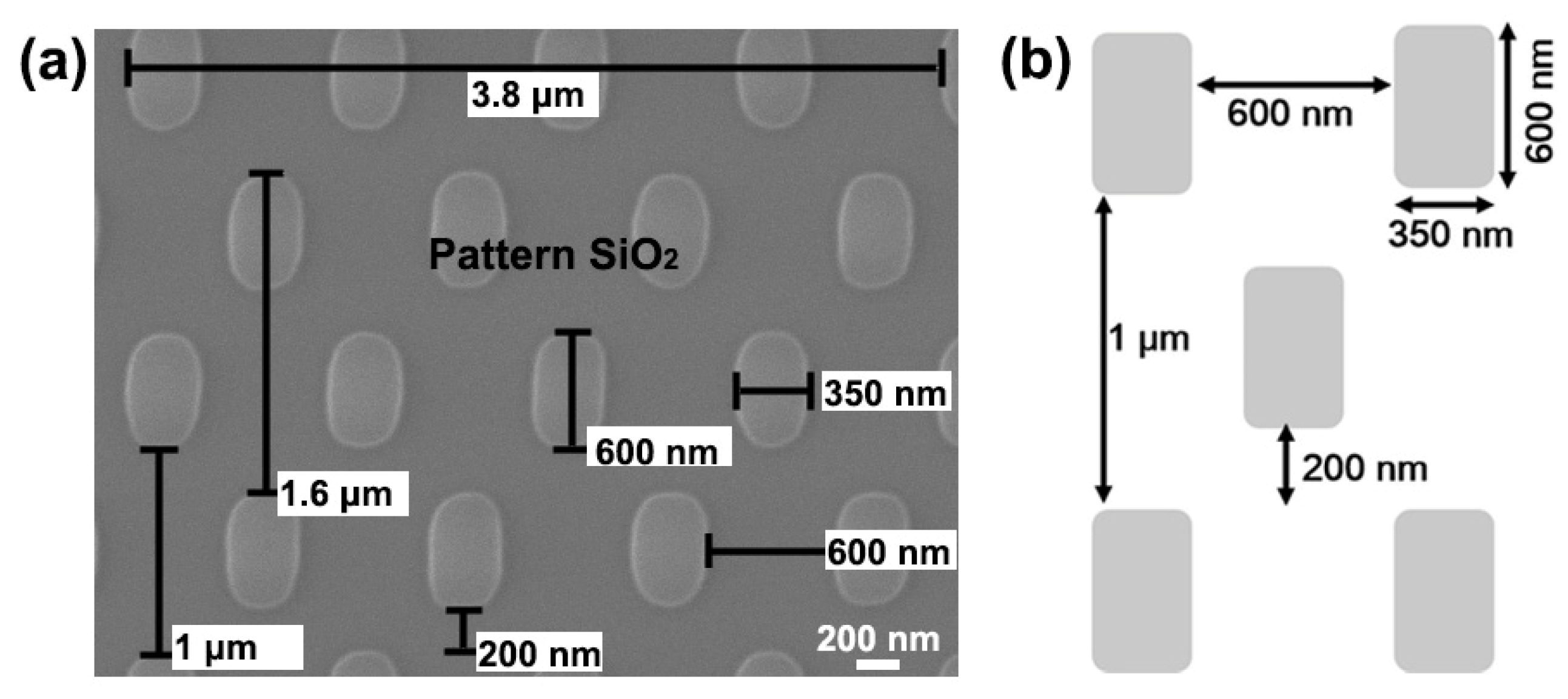

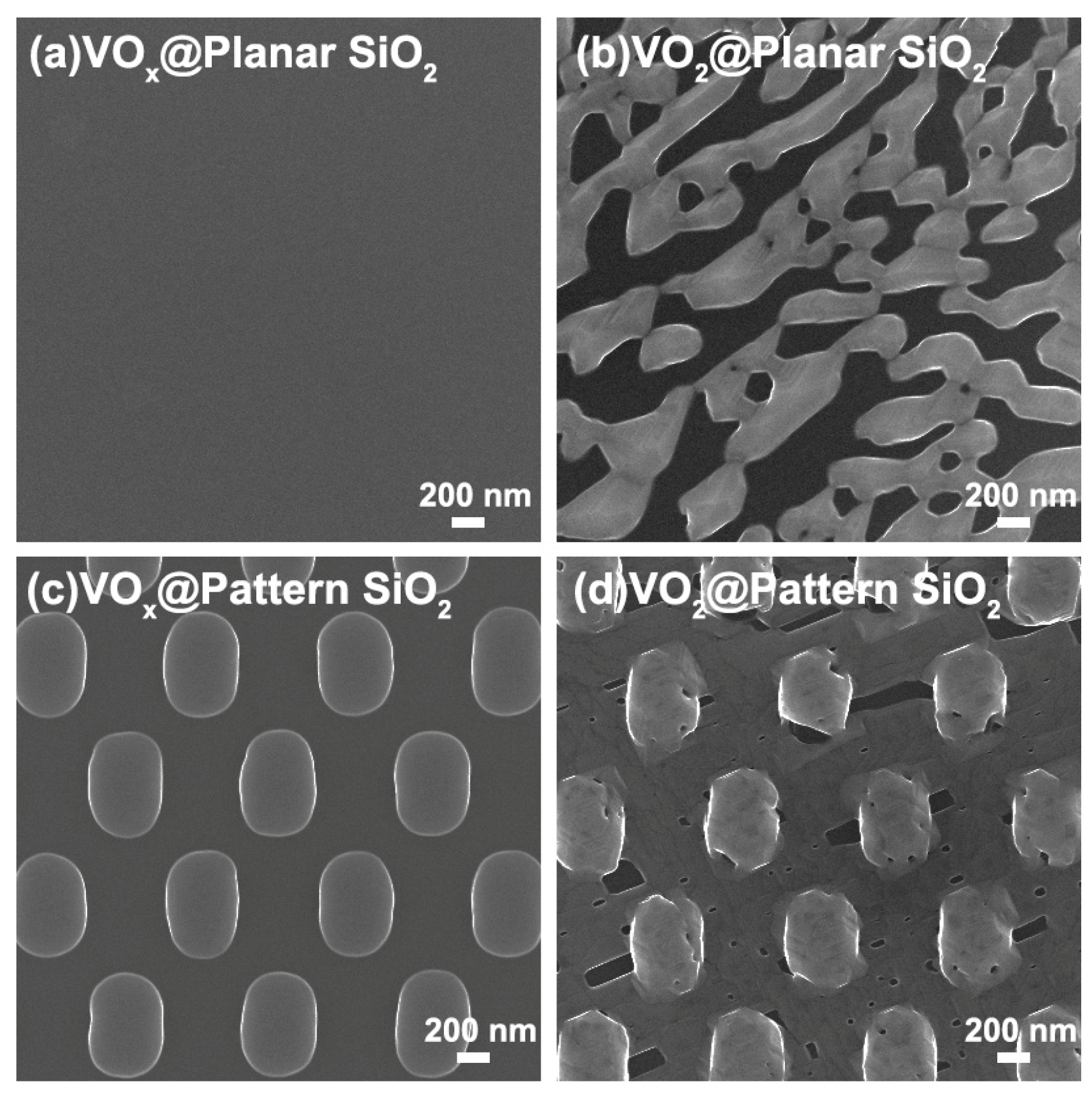
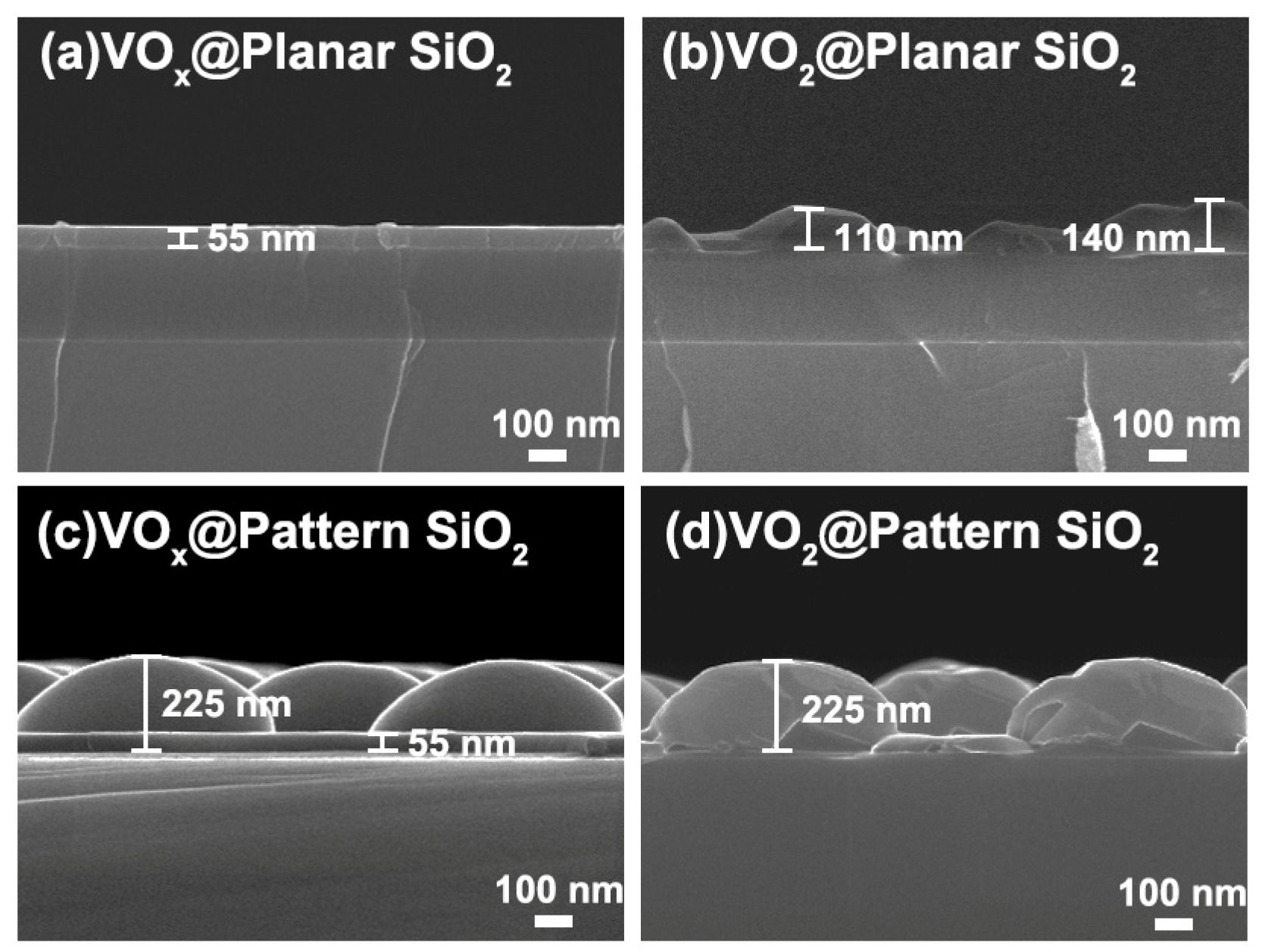

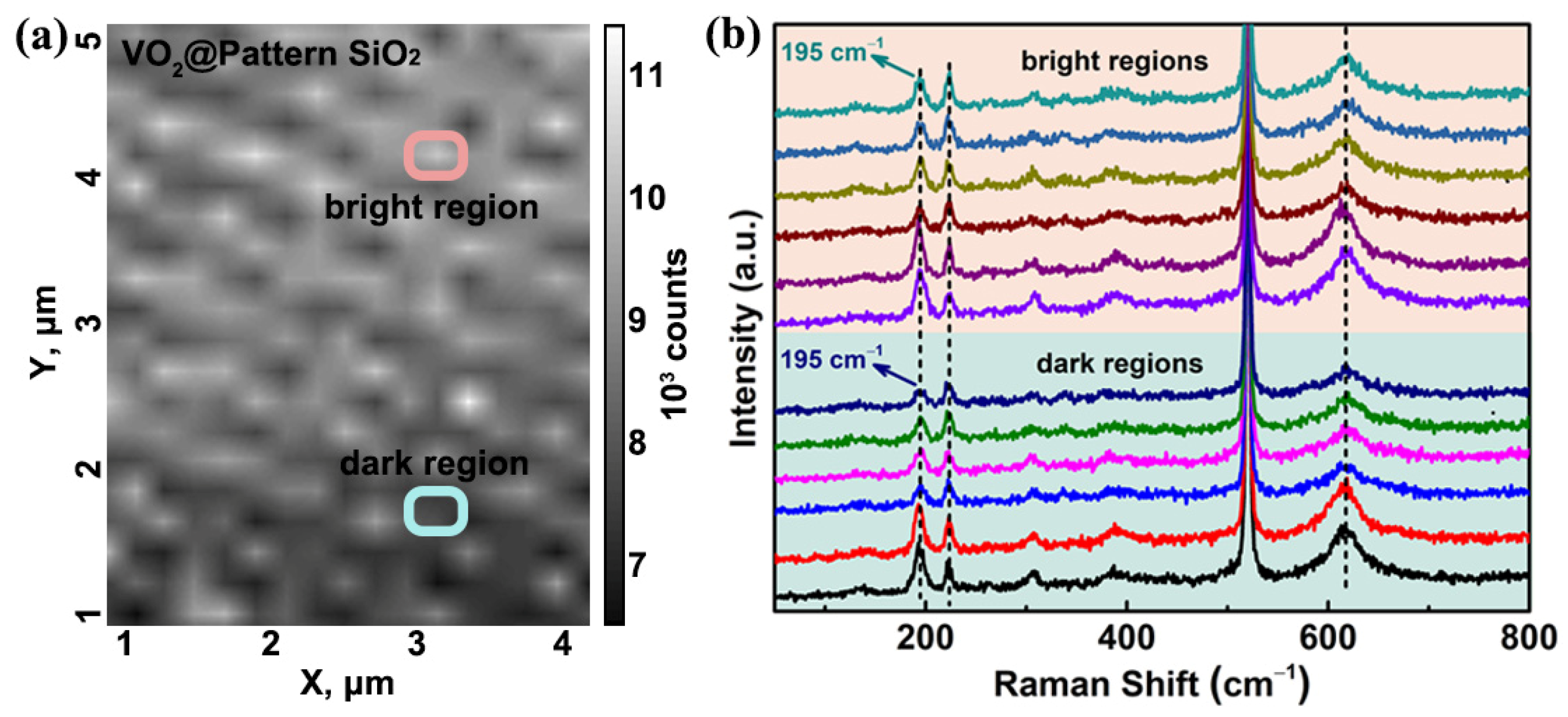
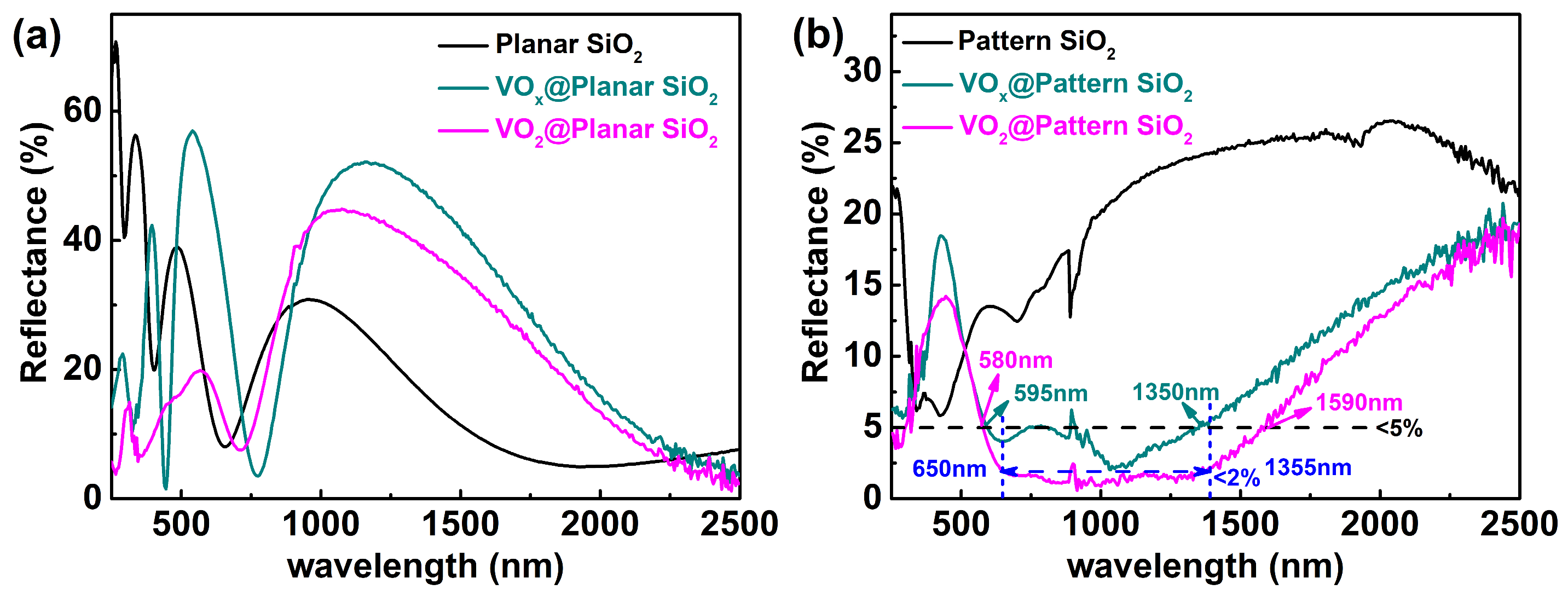
| Samples | Rw (%) | Reduced Rw over Pattern SiO2 (%) | Ranti (%) | Improved Ranti over Pattern SiO2 (%) |
|---|---|---|---|---|
| Pattern SiO2 | 17.0 | 83.0 | ||
| VOx@pattern SiO2 | 4.41 | 74.1 | 95.6 | 15.2 |
| VO2@pattern SiO2 | 1.80 | 89.4 | 98.2 | 18.3 |
| Samples | Rw (%) | Reduced Rw over Pattern SiO2 (%) | Ranti (%) | Improved Ranti over Pattern SiO2 (%) |
|---|---|---|---|---|
| Pattern SiO2 | 17.3 | 82.7 | ||
| VOx@pattern SiO2 | 4.13 | 76.1 | 95.9 | 16.0 |
| VO2@pattern SiO2 | 1.46 | 91.6 | 98.5 | 19.1 |
Disclaimer/Publisher’s Note: The statements, opinions and data contained in all publications are solely those of the individual author(s) and contributor(s) and not of MDPI and/or the editor(s). MDPI and/or the editor(s) disclaim responsibility for any injury to people or property resulting from any ideas, methods, instructions or products referred to in the content. |
© 2023 by the authors. Licensee MDPI, Basel, Switzerland. This article is an open access article distributed under the terms and conditions of the Creative Commons Attribution (CC BY) license (https://creativecommons.org/licenses/by/4.0/).
Share and Cite
Wang, S.; He, J.; Sun, P. Homogeneous Nanostructured VO2@SiO2 as an Anti-Reflecting Layer in the Visible/Near Infrared Wavelength. Materials 2023, 16, 6035. https://doi.org/10.3390/ma16176035
Wang S, He J, Sun P. Homogeneous Nanostructured VO2@SiO2 as an Anti-Reflecting Layer in the Visible/Near Infrared Wavelength. Materials. 2023; 16(17):6035. https://doi.org/10.3390/ma16176035
Chicago/Turabian StyleWang, Shuxia, Jiajun He, and Panxu Sun. 2023. "Homogeneous Nanostructured VO2@SiO2 as an Anti-Reflecting Layer in the Visible/Near Infrared Wavelength" Materials 16, no. 17: 6035. https://doi.org/10.3390/ma16176035





